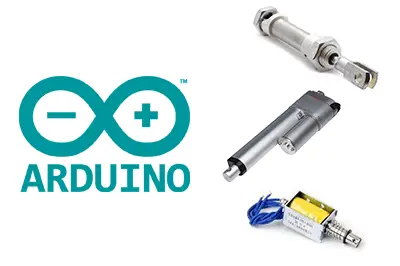In the previous two entries, we have seen the criteria to consider when choosing an actuator or motor to use in our Arduino projects, and the main types of rotary motors that we have available, along with their advantages and disadvantages.
Finishing with the selection guide by looking at the main types of linear actuators available, along with their operation, characteristics, advantages, and disadvantages.
The explanation of the operation of each type of actuator will be quantitative and without equations, as going into detail about each one would require a chapter of an electronics book. The goal is to explain simply how they work and their advantages and disadvantages.
Electromagnets
An electromagnet is a device that allows attracting ferromagnetic objects, such as Fe and some of its alloys.
An electromagnet consists of a coil wound around a ferromagnetic core. When a current is applied to the coil, a magnetic field is generated inside it, which generates an attractive or repulsive force on other materials.
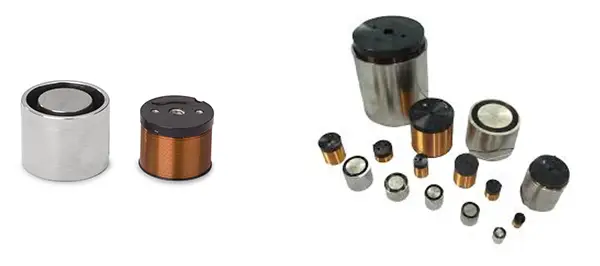
The ferromagnetic core of the electromagnet increases the power of the magnetic field and reduces losses due to dispersion.
We can use an electromagnet in our projects to create a small crane, or installed in a robotic arm to lift objects, or even to fix a robot to a metal sheet.
Magnetic actuators
Magnetic actuators are similar to an electromagnet, but in which the magnetic core is mobile. At the end, there is often a plastic piece, for example, with a small clamp.
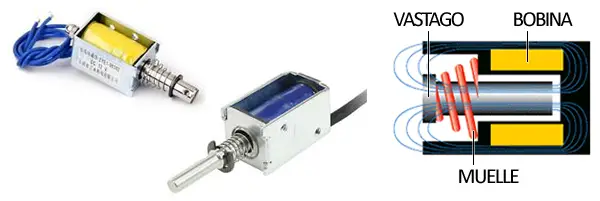
When current flows, the core is attracted into the electromagnet. There is a spring that returns the internal pin to its original position when the current ceases.
This type of magnetic actuators is widely used. They are very fast, but they have the disadvantage of having a small travel.
Linear actuators
Linear actuators consist of a direct current motor and a rod driven by a worm screw, inside a compact integrated unit.
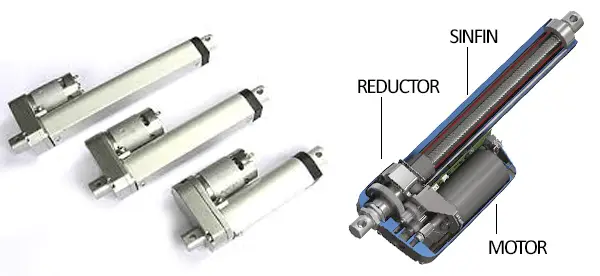
These types of actuators are available in a wide variety of lengths, some of which are very long. They can exert large forces. The drawback is that they are quite slow devices.
This type of linear actuators can move large loads and are used, for example, to mechanize awnings, lift loads.
Worm screw and sliding actuator motors
Similar to the previous ones, these actuators are also formed by a direct current motor that drives a worm screw. But in this case, there is an intermediate element that moves along the travel.
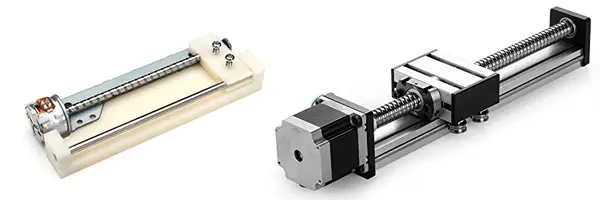
The slide is registered so that it does not rotate with the screw. This registration can be done through one or several guides or a lateral registration on one or both sides.
In this case, the characteristics of the actuator will depend on the motor used, which can be a DC motor or a stepper motor.
Linear motors
Linear motors operate similarly to a stepper motor, but instead of rotating a rotor, a slide moves linearly.
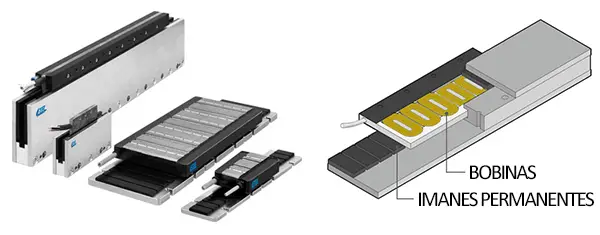
They consist of one or more rails along which alternating polarity magnets are arranged. Depending on the type of motor, there is a slide with electronically controlled coils above, between, or around the rail.
By varying the polarity of the magnetic field generated in the coils installed in the slide.
Linear motors have high speed, high torque, and high precision in movements. They are used, for example, as substitutes for worm slides in industrial CNC machines. You can also find them in magnetic levitation trains, and even in advanced weaponry such as railguns.
However, linear motors have a prohibitive price for home projects. (If you ever have access to one of these, you can lend it to me; I’m eager to play with one
Hydraulic and pneumatic
Of course, we couldn’t talk about actuators without mentioning hydraulic or pneumatic devices.
In these systems, a fluid (oil or water in hydraulics, air in pneumatics) is propelled along a series of pipes and actuators. Control is achieved by acting on the electronic valves located along the conduits.
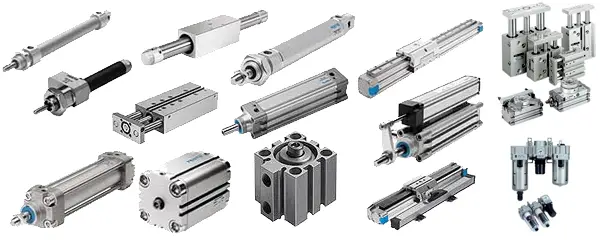
Hydraulic systems can exert large forces with great precision. They are widely used, from excavators, presses, and all kinds of automation.
Pneumatic systems have less precision and force, as they work with gas, which is a compressible fluid. However, they are faster than hydraulic systems. They are also widely used in industry to operate tools, eject parts, or perform movements.
However, hydraulic and pneumatic systems generally require the use of expensive and bulky equipment, making them out of reach for most home projects. Seriously, do not attempt to use these systems if you are not very clear about what you are doing.
Summary table
The previous information is summarized in the following table. Of course, they will depend on the particular model of each chosen motor, but broadly speaking and as a summary,
| Characteristics | Control (*) | |
|---|---|---|
| Speed | Force/Torque | |
| Electromagnet | – | ▲High |
| Magnetic actuator | ▲High | – Medium |
| Linear actuator (1) | ▼Low | ▲High |
| Linear actuator (2) | ▼Low | ▲High |
| Motor with worm screw and sliding actuator (1) | ▼Low | ▲High |
| Motor with worm screw and sliding actuator (2) | ▼Low | ▲High |
(*) With encoder, all switch to absolute control of position and speed (1) Driven by DC motor (2) Driven by stepper motor
Conclusions
Most of the devices invented by humanity to generate movement are rotary machines. To generate linear movement, it is most common to use a rotary motor accompanied by some mechanism that converts the movement into linear.
The electromagnet is a simple machine that we can use to attract ferromagnetic objects and lift loads. They can exert large forces, but they act over small distances. Additionally, we have no control over speed or position.
Electromagnetic actuators use an electromagnet to attract a small actuator. They are very fast, but the action distance is very small, and the force they can exert is usually small.
Linear actuators allow for moving large loads and can have quite long travels. In exchange, they are slow mechanisms. They can be combined with other types of mechanisms (levers, scissors, joints, etc.) to expand their range of action and speed, but reducing the force exerted. They can be used, for example, to retract an awning, lift platforms, open a door, for example.
Another common device is a motor with worm screw and sliding actuator. In general, they have low speed, high precision, and high torque, although it largely depends on whether it uses a DC motor or a stepper motor. They are very common in linear applications that require high precision, such as CNC machines or 3D printers.
Finally, linear motors are rare and extremely expensive. On the other hand, hydraulic and pneumatic solutions are only recommended for professionals and experienced installers, as they require a large number of elements and safety measures.
